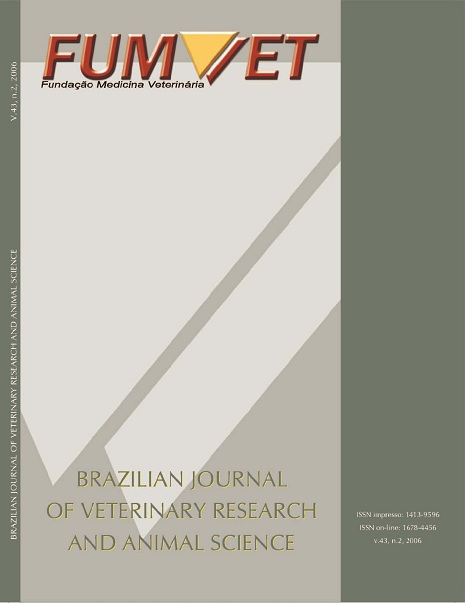Retrospective study of enterolithiasis and foreign bodies found in the large intestine of horses (january 1993 to january 2003)
DOI:
https://doi.org/10.11606/issn.1678-4456.bjvras.2006.26505Keywords:
Horse, Surgery, Entrolithiasis, Foreign body, Acute abdomenAbstract
In the period from January 1993 to January 2003, 195 surgical procedures of equine acute abdomen were performed at the Service of Large Animal Surgery of the Veterinary Hospital of the School of Veterinary Medicine and Zootechnics of the University of São Paulo. From these 195 cases there were 30 enterolithiasis and seven foreign bodies located in the colon. Thirty-five out of 37 laparotomies were performed in dorsal recumbency, with access through the ventral midline and two were performed through the flank, with the animal in standing position. Of the 37 animals, 25 were male and 12 were females. Age varied from one to 18 years old with any average of eight years of age. Location of enteroliths and foreign bodies was as follows: 13 (35.14%) in large colon, 19 (51.35%) in small colon, 03 (8.10%) in transverse colon and 02 (5.41%) in both transverse and small colon. In regards to the clinical evolution, six were humenely eutmanized killed during surgery. From the 31 remaining, 23 (74,19%) were discharged, 6 (19,36%) died and 2 (6,45%) were killed eutmanized during the post-operative period. Among those animals with satisfactory evolution two animals stand out. One of them had seven enteroliths and in the other, the nucleus of the mass was the tip of a nail, which protruded from the mass and was in constant contact with the intestinal mucosa. In spite of the large incidence of obstruction caused by enteroliths or foreign bodies in comparison of other studies, the prognosis of post-operative recovery is favourable.Downloads
Download data is not yet available.
Downloads
Published
2006-04-01
Issue
Section
UNDEFINIED
License
The journal content is authorized under the Creative Commons BY-NC-SA license (summary of the license: https://
How to Cite
1.
Corrêa RR, Zoppa AL do V, Silva LCLC da, Fernandes WR, Baccarin RYA, Cruz RSF da, et al. Retrospective study of enterolithiasis and foreign bodies found in the large intestine of horses (january 1993 to january 2003). Braz. J. Vet. Res. Anim. Sci. [Internet]. 2006 Apr. 1 [cited 2024 Jul. 26];43(2):242-9. Available from: https://www.revistas.usp.br/bjvras/article/view/26505





